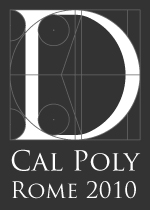Walking through through the scattered ruins of ancient Rome it’s difficult to imagine the Rome which was the Roman Empire. The same Rome which Piranesi and hundreds others idolized and wished to have seen. Like many of us, hundreds of years later, can simply hope to image. What we see today is a different Rome, one that has buried the old and grown into its own character. But what could that ancient Rome have been? Not even Nolli’s map, the iconic map of Rome, describes the ancient city. Until, well… Google. It’s a map that is more SketchUp than sketches. But after decades of collaboration between archeologists, historians, and others; there’s a map of ancient Rome, and it’s in three dimensions. It might not have the people, sounds and smells of ancient Rome, but it’s a start. To bring into being the rest of the character of that ancient place? Well, that’s up to us.
Between the Mountains and the Sea lies a single, weaving thread. The thread weaves the hearts of the Coast together; cities lost between the sea and the sky. Cities whom reach the sea, spilling their blood into it, and those which rise into the mountains above the splender. The road which connects them remains between, perilously balanced between the two. A road which brings life, eyes, hearts and minds. It makes no distinction between resident and transient, there are only those motion and those who pause. They are the blood which flows through a single, thin vein. The life which flows through Amalfi.
What’s the difference between a big building and a small city? In the topic of program and function? There really isn’t a difference. The simple answer could be scale, the number of residents, but even that can be questioned. Maybe it’s their contrasting lives. In the case of the Colosseum, the Pantheon, the Vittorio Emmanuelle, and the MAXXI? They all die at sunset. Becoming the majestic, dissolving carcasses of both ancient and modern civilizations; but Rome lives on. Even a city like Castelvecchio Calvisio continues to breath, even if it’s just a whisper. The cities? They continue. They outlive their pieces. Until, in the case of Ostia Antica, they all die together. The life of a city is a constant one: in continues in the corners, in the piazzas, in the alleyways, in the windows above the streets. The large buildings sit quietly apart, sentinels in the dark.
Eternal Life in the Eternal City
I never get tired of their faces, the people I mean. They all seem surprised I’m here, ha, as if I look out of place.. you should see what they wear. You wouldn’t believe it, but I saw some tourists wearing tinfoil hats a week ago and another group riding.. Segways, ha! Imagine gladiators charging one another on Segways! Aurelian, what about you, anything entertaining? You see more tourists than I do after all.
Piramide, I’m tired of tourists, I’m tired of holes being punched of me, I’m tired of being driven around and through and under and becoming a hinderance for some kid trying to get into the ancient city instead of being a proud sentinel like in the old days.
Oh Aurelian, be happy won’t you? We’re revered members of society now, people want to go about preserving us instead of pulling dead emperors out of me and turning you into someone’s kitchen wall. Though Aurelian.. you should really cover up, that kid is taking a photo and your brick is showing.
Thousands of buildings in Rome are not seen by its inhabitants, their sites hidden within the ground. They are buried in the detritus of time, but they are still alive in a way. Many of the buildings in the ancient city are built on top of ancient buildings, their old walls have been uncovered and used as foundations for new buildings. Some underground buildings are even visitable today, and have been re-purposed. The Basilica di San Clemente is one such building. It is a complex of three buildings: a 12th century basilica, built upon a 4th century nobleman’s home, built upon a 1st century mithraeum. The true nature of its meeting with the ground is not visible from the outside, and may not even affect the exterior context in a significant way; but, these layers of connections are what allow the current Rome to exist. The ancient and medieval provide the foundation of the new Rome.
It all begins with one step. Off the train into a new place, one I hadn’t seen, a place I had purposefully avoided. I wanted it to be completely new. It seemed like Milano at first, a busy train station filled with noise and people down to a crowded metro rushing through dark tunnels to an unkempt Trastevere station. Walking through the streets, I watched the street turn from asphalt into stone while the city gained a richer character, the charm exuded by an older Italian city. Eventually, I made my way to the Pantheon, stealing glances while quickly moving to meet those already there. Relieved to find everyone and finally having arrived, I didn’t even take the time to look up while everyone around me looked skyward. Walking along the streets in the next days, I looked and listened; Italy was familiar, but this city was not. There were those from all over the world here for a short moment and those who had lived here their entire lives, moving through the city in their own ways. The streets weaved and rushed through a constantly changing city fabric, thousands of years moving by in seconds, a quality unlike any place in the world. Eventually, we made our way back to the Pantheon in an effort to understand how a place can alter how one perceives. There once more, I finally looked up.
I’m here, I’m in Rome.






